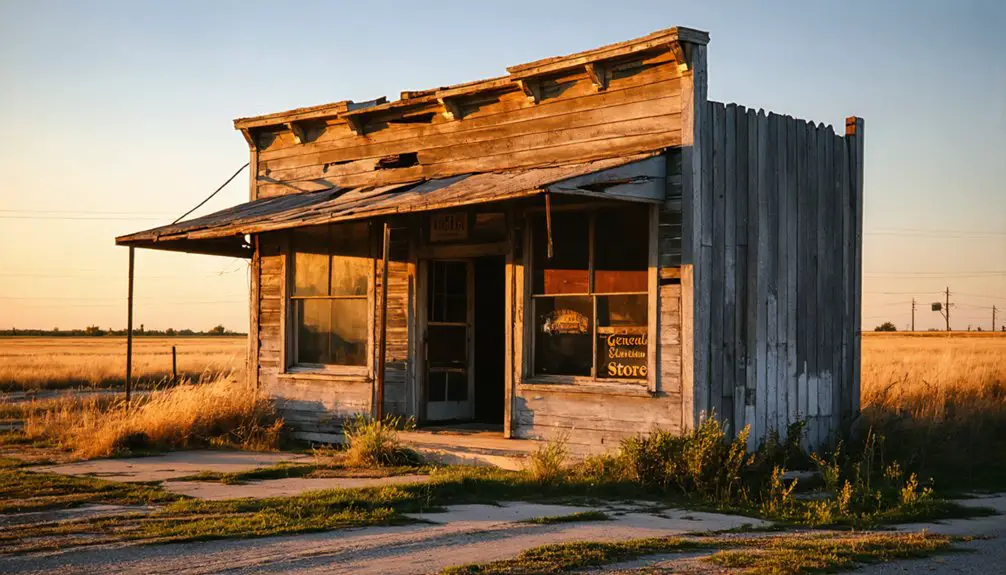You’ll find Agawam’s abandoned remains in Grady County, Oklahoma, where the Rock Island Railroad established this settlement in 1909. The town flourished briefly as a rail hub and oil boom community, boasting a post office, school, and legendary girls’ basketball team. A catastrophic 1915 train collision killed seven people and marked the beginning of Agawam’s decline. By 1918, the post office closed, leaving behind a ghost town whose tragic story echoes through Oklahoma’s prairie landscape.
Key Takeaways
- Agawam, Oklahoma emerged in 1909 along the Rock Island Railroad but declined into a ghost town following a devastating 1915 train collision.
- The town’s post office closed in 1918, marking a crucial step in Agawam’s transformation from a promising railroad hub to abandonment.
- Despite brief prosperity from oil and gas discoveries in the 1920s, Agawam failed to sustain economic growth or recover from the train disaster.
- The community’s last notable achievement was its girls’ basketball team’s 90-4 record before the town’s complete abandonment.
- Agawam’s name, derived from Native American language meaning “other side of the marsh,” remains one of few traces of this ghost town.
From Native American Name to Oklahoma Settlement
While the name “Agawam” originated from a Pawtucket village in New England meaning “other side of the marsh,” it found an unlikely home in Oklahoma during the early 20th century. The Agawam origins had no direct connection to Oklahoma’s Native heritage, as the name was borrowed during the railroad expansion of 1909. Similar to other disambiguation name cases, this term would later require clarification to distinguish it from other locations called Agawam. Historical accounts show that the Western Abenaki dialect was the original language of the term Agawam. You’ll find that this cultural borrowing occurred when the Rock Island Railroad established its main line through the area. The settlement quickly developed around the railroad, featuring a post office and school facilities.
Railroad Boom and Early Development
Agawam’s pivotal growth began when the Chicago, Rock Island & Pacific Railroad established its mainline through the settlement, spurring a surge in town lot sales and new construction.
You’ll find that the railroad’s presence positioned Agawam as an essential shipping point, though this prosperity was jolted by a significant train collision in 1915 that highlighted the risks of increasing rail traffic. This era of railway development mirrored other Oklahoma towns like Ada, which saw similar expansion when the Oklahoma Central Railroad arrived. By 1910, the town benefited from Oklahoma’s extensive rail network coverage, which had reached six thousand miles across the territory.
Rock Island Line Impact
As the Chicago, Rock Island and Pacific Railroad expanded into Oklahoma Territory in 1888, it laid the foundation for Agawam’s establishment and early development.
You’ll find this railroad expansion created a crucial link along the thirty-fifth parallel, connecting Agawam to markets across the region and beyond to the Gulf of Mexico.
The economic transformation was immediate when Agawam emerged in 1909. The railroad’s diesel-powered streamliners revolutionized transportation efficiency in the region starting in 1940.
Following the railroad’s Choctaw, Oklahoma and Gulf acquisition in 1904, the network’s reach expanded significantly throughout the territory.
You can trace the town’s growth through its strategic position as a shipping point for a nearby gas field, just four miles from an Oklahoma Gas Company pumping station.
The railroad’s presence sparked local commerce, leading to town lot auctions in 1923 and the development of essential infrastructure, including a post office, gymnasium, and grade school that served the community through the 1950s.
1915 Train Disaster Aftermath
On October 19, 1915, a catastrophic head-on collision between a southbound passenger train and northbound freight train devastated Agawam’s rail corridor, leaving seven dead and numerous injured.
Similar to the deadly Dutchman’s Curve collision in Nashville three years later, miscommunication between railway personnel led to the tragic incident.
Engineer William Powell bore responsibility for the tragedy, which prompted immediate safety reforms across the Rock Island Railroad’s operations. Much like the Norfolk Southern derailment in East Palestine, the incident highlighted environmental and community impacts.
The disaster recovery efforts revealed the challenges of emergency response in rural Oklahoma, yet you’ll find that Agawam’s community resilience shone through.
By 1922, the town had leveraged its strategic location near the Grady County gas field, becoming a crucial shipping point.
Despite the accident’s initial impact on population growth, Agawam experienced a brief economic surge, marked by a significant town lot auction in 1923 and ongoing infrastructure development, including a new gymnasium in 1935.
Town Lots Sale Surge
Located strategically along the Rock Island Railroad’s main line, the rural settlement of Agawam emerged in 1909 during Oklahoma’s railroad expansion period.
You’ll find that Agawam’s lot speculation peaked in 1923 when it earned the “new oil town” designation, attracting investors due to its prime location just four miles from Oklahoma Gas Company’s pumping station.
Investment trends show the town’s development was driven by both railroad access and energy sector growth. Like the Oklahoma Central Railroad, the area’s rail development focused heavily on transporting coal and other energy resources. The discovery of oil fields in the 1920s led to a surge in new branch lines being constructed to service the growing industry.
- Post office operations from 1909-1918 marked the initial settlement phase
- Railroad access enabled profitable shipment of coal, oil, and gas resources
- 1922 announcement as a gas field shipping point sparked renewed interest
- 1923 town lot auctions capitalized on the energy sector boom
The combination of rail infrastructure and energy production made Agawam’s lots particularly attractive to speculators seeking economic opportunity.
The Fatal Train Collision of 1915
On October 19, 1915, a devastating head-on collision between a southbound Rock Island Railroad passenger train and a northbound freight train near Agawam, Oklahoma claimed seven lives.
Engineer William Powell’s error led to the crash on the railroad’s main line, resulting in numerous injuries alongside the fatalities.
The tragic accident, occurring during an era of frequent rail disasters across America, marked a turning point in Agawam’s history and contributed to the town’s eventual decline.
Tragic Head-On Crash
During the early morning hours of October 19, 1915, a catastrophic head-on collision between a southbound passenger train and a northbound freight train claimed seven lives in Agawam, Grady County, Oklahoma.
This devastating crash on the Rock Island Railroad’s main line exposed serious flaws in train safety protocols and left an indelible mark on the small community. The collision, occurring on a single-track section, resulted from critical coordination failures and inadequate safety measures, leading to both trains occupying the same track simultaneously.
- Seven people lost their lives, including crew members and passengers
- The crash contributed to Agawam’s eventual decline, with its post office closing by 1918
- Communication and signaling errors highlighted systemic safety issues
- The incident sparked demands for improved railroad safety standards in Oklahoma
Engineer Powell’s Fatal Error
While operating his train near Agawam in 1915, Engineer Powell made a catastrophic error that led to one of Oklahoma’s deadliest rail disasters.
You’ll find that Powell’s critical mistake involved either passing a stop signal or misinterpreting dispatch orders on the single-track corridor, resulting in a devastating head-on collision. Despite attempting emergency braking, he couldn’t prevent the impact.
The investigation highlighted both engineer accountability and potential signal malfunction as contributing factors. Powell had received ambiguous information about train movements ahead, and the route’s limited safety infrastructure – relying on telegraph and voice signals – complicated operations.
The tragedy spurred major changes in railroad safety, including enhanced signal systems and stricter protocols. For Agawam’s residents, the collision’s aftermath brought profound loss and sparked demands for reform.
Lives Lost That Day
Tragedy struck Agawam’s railway corridor when a devastating head-on collision claimed seven lives on October 19, 1915. The victim demographics included both railroad employees and passengers, though exact numbers of each weren’t recorded.
The economic impact rippled through the small Oklahoma community as families lost breadwinners, leaving widows and orphans to navigate a time with limited social support.
- Train crews, including engineers and conductors, were among the confirmed casualties
- Multiple survivors suffered injuries ranging from minor to critical conditions
- Local medical response faced significant challenges due to 1915’s limited infrastructure
- The incident’s aftermath contributed to Agawam’s eventual decline into a ghost town
The collision stood as one of several deadly railway accidents in Oklahoma during 1915, highlighting the era’s dangerous transportation landscape.
Oil and Gas: The Economic Drivers
As oil and gas discoveries transformed Oklahoma’s economic landscape in the early 1900s, Agawam emerged as a strategic hub for the region’s petroleum industry.
You’ll find the town’s origins closely tied to the 1922 development of nearby Grady County gas fields, just four miles from Oklahoma Gas Company’s essential pumping station.
The economic impact was swift and dramatic. By 1923, Agawam was marketing itself as a “new oil town,” with town lots auctioned to enthusiastic investors.
New wealth flowed into Agawam as quickly as the oil, transforming a quiet prairie town into a bustling investment opportunity.
The Rock Island Railroad’s main line through Agawam provided crucial transportation for oil and gas products, cementing the town’s importance during Oklahoma’s oil boom.
During this period, the state led all Mid-Continent regions in oil production, reaching a peak of 762,000 barrels per day in 1927.
Small Town Glory: Basketball Legacy

Despite its small size, Agawam left an indelible mark on Oklahoma’s basketball history through its exceptional girls’ team of the mid-1950s.
You’ll find that basketball pride ran deep in this small town, where the 1935 gymnasium became the heart of community cohesion. The girls’ team achieved an astounding 90-4 record over three years, competing with just seven players due to the school’s limited enrollment.
- The team’s success brought regional attention despite Agawam’s declining population
- A state-of-the-art gymnasium, built in 1935, served as both athletic facility and community hub
- Players demonstrated remarkable versatility and commitment to maintain their winning legacy
- The program exemplified Oklahoma’s passionate basketball culture, even as the town faced economic challenges
The Path to Abandonment
The railroad tracks that once brought prosperity to Agawam ultimately led to its downfall.
When you look at Agawam’s decline, you’ll find a town that couldn’t sustain its community resilience after the devastating 1915 train collision that killed seven people. The lack of economic diversification left the town vulnerable – first depending on the railroad, then on oil and gas discovered in 1922-1923.
As these resources depleted and transportation patterns changed, you’d have seen families moving away, seeking opportunities elsewhere. The closure of the post office in 1918 marked the beginning of the end.
Frequently Asked Questions
Are There Any Remaining Buildings or Structures Still Standing in Agawam Today?
You’ll find multiple abandoned houses and concrete ruins from former industrial sites still standing today. These remaining structures hold historical significance as evidence of Agawam’s past industrial and residential development.
What Was the Peak Population of Agawam During Its Boom Years?
Like a mirage in the desert, Agawam’s peak population remains a mystery. You won’t find exact numbers, but economic factors from gas and railroad industries suggest it briefly supported enough people for a school and gymnasium.
Did Any Famous People or Notable Historical Figures Visit Agawam?
You won’t find any documented celebrity sightings or historical visits by famous figures in this town’s records. It primarily served as an oil shipping point without attracting any nationally notable personalities.
Were There Any Churches, Hotels, or Businesses Operating in Agawam?
During its 9-year post office operation, you’d find limited business activity focused around postal services and later gas shipping. There’s no documented church history or hotels in historical records.
What Happened to the Residents When the Town Was Abandoned?
You’ll find most residents relocated to areas with better job prospects after oil and railroad work dried up, while some stayed until the 1950s before finally moving to nearby towns.
References
- https://en.wikipedia.org/wiki/Agawam
- https://en.wikipedia.org/wiki/List_of_ghost_towns_in_Oklahoma
- https://www.okhistory.org/publications/enc/entry?entry=GH002
- http://genealogytrails.com/oka/grady/towns.html
- https://freepages.rootsweb.com/~gtusa/history/usa/ok.htm
- https://historicipswich.net/2021/04/21/who-were-the-agawam-indians-really/
- https://www.library.pima.gov/content/states-that-have-names-from-native-american-languages/
- https://historicipswich.net/2022/10/21/living-descendants-of-the-native-americans-of-agawam/
- https://www.wikiwand.com/en/articles/List_of_place_names_of_Native_American_origin_in_the_United_States
- https://en.wikipedia.org/wiki/Oklahoma_Central_Railroad_(1914–1942)



